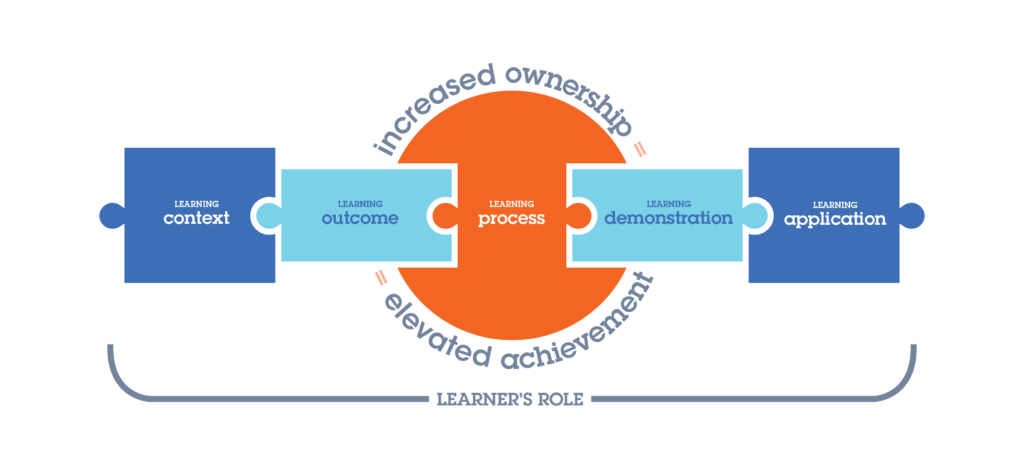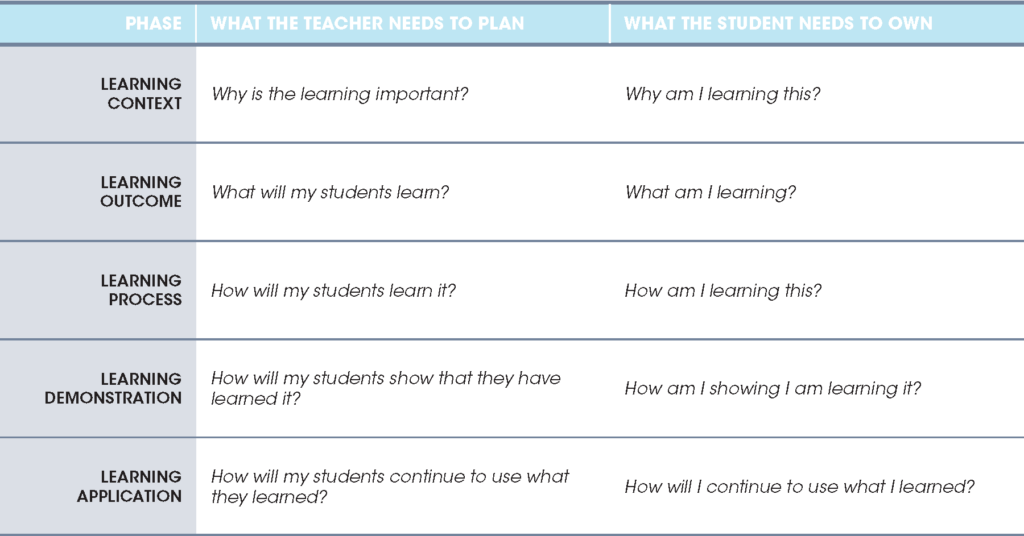Share this article.
Madeline Hunter astutely observed,
“…teaching can be defined as a constant stream of professional decisions made before, during, and after interactions with students; decisions which, when implemented, increase the probability of learning…
Consequently, it is important for teachers to consciously and deliberately identify the decisions they must make in each category and base their decisions on research-validated knowledge.”
Therefore, it is critical for teachers to deliberately make the decisions that will increase students’ probability of learning and overall motivation.
One of the most effective decisions you can make is to use a focused Learning Model that guides and focuses your lesson planning and delivery. Elevated Achievement’s Learning Model is driven by the learner and answers the question—What does a learner need to know in order to better own his learning? This model is the most effective device you can use to focus your lessons, thereby increasing your students’ motivation and opportunities to own their learning.
In another of our articles, we provided an overview of the Learning Model and its five student-centered phases: setting the Learning Context, stating the Learning Outcome, engaging in the Learning Process, producing the Learning Demonstration, and implementing the Learning Application. In this article and subsequent articles, we will discuss the sequence of planning a focused lesson and take an in-depth look at each of the five phases that lead to increased ownership and elevated achievement.
The Sequence of Planning
Remember, teaching is a constant stream of decisions made before, during, and after interactions with students. Therefore, the purpose of delineating this planning sequence for a focused Learning Model is to support a teacher to reflect on their own decision-making as they decide what they and their students need to know for each lesson.
When planning a lesson, the teacher must take into consideration both the design and delivery of the lesson. However, the sequence for designing a lesson is different from delivering a lesson.
In order to most effectively and efficiently backwards design a lesson, the following decision-making sequence is recommended:
- Determine the Learning Context and the Learning Application
- Determine the Learning Outcome and the Learning Demonstration
- Determine the Learning Process
In other words, first determine why students are learning this skill right now and how they will use it in the future. Next, determine the specific skills they are learning and what a demonstration of mastery will look and sound like. Finally, determine the instructional strategy or strategies that will allow students to engage, collaborate, and achieve mastery.
You can download a lesson planning template to use as you design a focused lesson.
This clarity of decision-making will allow your students to understand their role in their own learning. That is, if you let them in on your decision-making. So, determine how you want to communicate these decisions to your students by always answering the question:
- How will I share this information with my students before, during, and after the lesson?
Sharing this information with your students will help them answer the question, “What is my role in the learning?” In turn, students who are supported by teachers who share their thinking and model the skill of ownership can more readily articulate their answers the following questions:
- Why am I learning this?
I am learning this because… - What am I learning?
I am learning… - How am I learning this?
I am learning this by… - How am I showing I am learning it?
I am showing I am learning it when… - How am I using this learning later?
I am going to use this later because… - What is my role in the learning?
My role is…
Once you’ve made your planning decisions, forward instruct through the five phases of the lesson with the end in mind, always remembering to share your decisions with your students.
What’s Next in Learnership?
When we own something, it’s ours. It belongs to us. No one else can ever take it away. Isn’t that what we want our children to feel about their learning? Yes, it is.
But it is much more than a feeling. Learnership is also the life skill our children need to be successful in the future. In other words, success in the future is not about what we know, but rather, what we can do with what we know. This is exactly what colleges and employers are looking for.
We at Elevated Achievement believe that learnership is the most important thing we can help our students develop. That’s why we do what we do.
And, that’s why we wrote this article as a part of a series to provide you with the knowledge and tools you need to implement a focused Learning Model for each and every lesson. Delve deeper into how to utilize a focused Learning Model by checking out the other articles in this series…
- “How to Set Out for Your Students Why This Learning Is Important”
- “How to Support Your Students to Know What They Are Learning”
- “How to Engage Your Students in the Learning Process”
- “How to Empower Your Students to Demonstrate Their Learning”
- “How to Ensure Your Students Apply What They Have Learned”
…Because when you do, you will be building your learnership to provide your students with opportunities to develop their learnership and elevate their achievement each and every day.
Continue the Learning
Check out these articles and resources to continue your learning about this topic…
The Learning Brief
In this article you learned…
- Teaching is a constant stream of decisions made before, during, and after interactions with students and it is critical for teachers to deliberately make the decisions that will increase students’ probability of learning.
- The purpose of a focused Learning Model is to support a teacher to reflect on their own decision-making as they decide what they and their students need to know for each lesson, thereby increasing students’ probability of learning and motivation.
- Teachers utilizing a Learning Model will be supporting their students in knowing what they are learning, why they are learning it, how they will learn it, how they will show they have learned it, how they will continue to use what they learned, and what their role is in the learning.
Can you imagine building an environment full of motivated, engaged, and eager students who own their learning?
We can.




